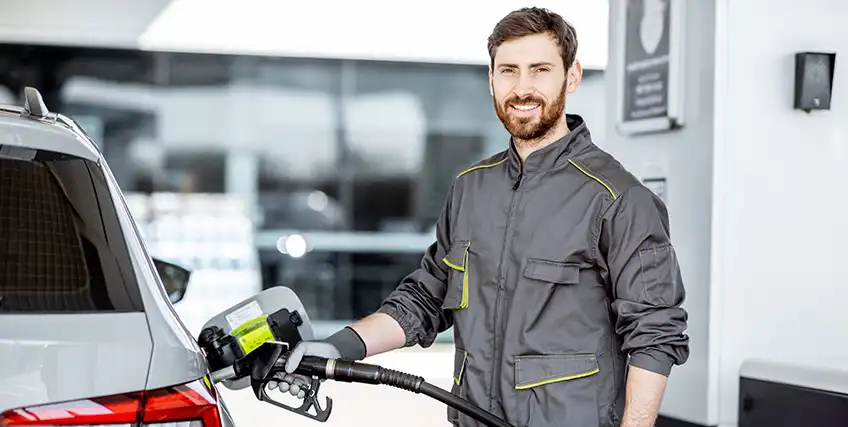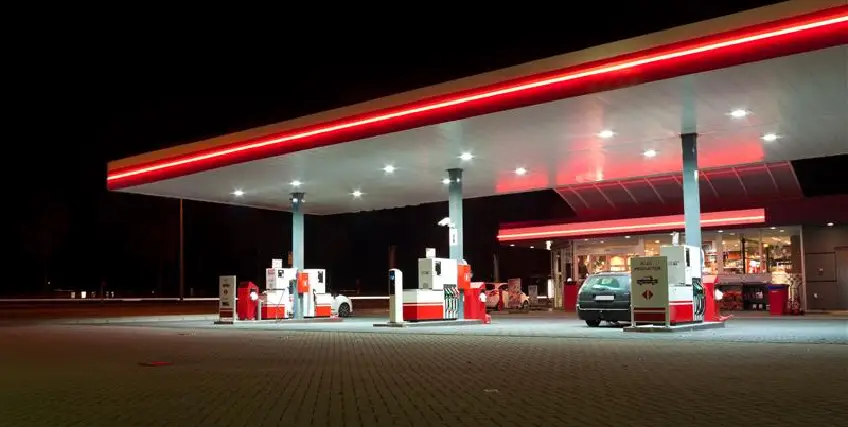Top 10 Tips for Finding a Perfect Gas Station Location
January 28, 2025 | Last Updated on: January 29, 2025

Top 10 Tips for Finding a Perfect Gas Station Location
Opening a gas station location can be a very lucrative venture. According to Projection Hub, the average sole proprietorship gas station makes $1.3 million in annual revenue. They’re relatively recession-proof, offer steady revenue streams, and offer the potential to develop multiple revenue streams if you open a convenience store or auto shop. If fuel prices rise worldwide, you may see even bigger profits at the fill-up station.
The location of a gas station makes a big difference. Finding the right place to do so could make the difference between your small business's success and failure. Here, we break down some tips to find the right location.
In this article:
- The best states to open a gas station location
- How to find the ideal location of a gas station.
- How to find the best gas station financing
Identify the areas with the most vehicles
Unsurprisingly, the most populous states tend to have the most vehicles. However, they also have an abundance of gas stations so, for more people, the nearest gas station is never very far away. However, America is a driving country, and many of the states with the most vehicles lack quality public transportation options.
According to Statista, the most populous states are, in order:
- California: 30.4 million
- Texas: 22.4 million
- Florida: 18.5 million
- New York: 11.3 million
- Pennsylvania: 10.1 million
- Ohio: 10.1 million
- Illinois: 10.6 million
- Georgia: 8.8 million
- North Carolina: 8.7 million
- Michigan: 8.5 million
Identify a discrepancy in vehicles and gas station locations
Based on that data, you’d think the states with the most gas stations would have a similar top ten, right? order down like this:
- Texas
- California
- Florida
- Georgia
- Alabama
- North Carolina
- New York
- Michigan
- Pennsylvania
- Ohio
Based on this data, states like Pennsylvania and Ohio appear underserved, while Alabama and Texas are already crowded markets.
Assess fuel demand
Some states consume fuel at much higher rates than others. This may be due to lifestyle, the lack of public transportation, a larger trucking industry, or many other factors. According to data from Commodity.com, the most gas-hungry states might surprise you.
The following states have the highest demand for gasoline based on a variety of factors:
1. Mississippi
- Per person annual gasoline use: 578 gallons
- Per person annual gasoline spending: $1,324
- Total annual gasoline use: 1,722,554,239 gallons
- Total annual gasoline spending: $3,943,000,000
- Average price per gallon of gasoline compared with U.S. average: -11.9 percent
- Per person annual vehicle miles traveled: 13,850 miles
2. North Dakota
- Per person annual gasoline use: 577 gallons
- Per person annual gasoline spending: $1,498
- Total annual gasoline use: 440,308,622 gallons
- Total annual gasoline spending: $1,144,000,000
- Average price per gallon of gasoline compared with U.S. average: 0.0 percent
- Per person annual vehicle miles traveled: 12,839
3. Alabama
- Per person annual gasoline use: 570 gallons
- Per person annual gasoline spending: $1,301
- Total annual gasoline use: 2,798,198,295
- Total annual gasoline spending: $6,385,000,000
- Average price per gallon of gasoline compared with U.S. average: -12.2 percent
- Per person annual vehicle miles traveled: 14,576
4. Wyoming
- Per person annual gasoline use: 569 gallons
- Per person annual gasoline spending: $1,474
- Total annual gasoline use: 330,146,731 gallons
- Total annual gasoline spending: $855,000,000
- Average price per gallon of gasoline compared with U.S. average: -0.4 percent
- Per person annual vehicle miles traveled: 17,530
5. Delaware
- Per person annual gasoline use: 561 gallons
- Per person annual gasoline spending: $1,457
- Total annual gasoline use: 547,438,138 gallons
- Total annual gasoline spending: $1,423,000,000
- Average price per gallon of gasoline compared with U.S. average: 0.0 percent
- Per person annual vehicle miles traveled: 10,382
Although all of these states have smaller populations, they are all heavy highway commuting states and, in some cases, have significant trucking industries. While gas is cheaper in most of these states, thereby potentially limiting profits, the right location of a gas station could find significant demand.
Assess miles of roads
The most populous states don’t necessarily have the most roads and most gas stations. While Texas and California have the most road miles, according to the U.S. Department of Transportation, states like Kansas and Minnesota also crack the top five. Notably, neither is in the top ten states with the most gas station locations.
Compare amenity competition
According to data from IBISWorld, California, Texas, and Florida are the states with the most gas station and convenience store combos. Convenience stores are a great way to diversify revenue streams and raise your business’s profit potential, but they’re incredibly competitive.
Data from Safegraph.com notes that the states with the highest foot traffic at gas stations with convenience stores include Oklahoma, South Carolina, Arkansas, Tennessee, and Alabama. Basically, the data suggests that Southern states typically utilizes gas station convenience stores more than Northern ones.
Consider road trip destinations
The American road trip is a classic family vacation, but if you’ve ever done one, you know just how few and far gas stations can be between destinations. Many travelers use what little cell service they have to search for gas stations in this area as they’re getting low on fuel in the middle of a quiet stretch of highway. Setting up shop in a rural area on a well-traveled route to national parks and other American landmarks can carve out a nice niche — especially if you provide services like a public restroom and convenience store.
Consider trucking routes
Who says you only have to serve passenger vehicles? Setting up a truck stop with top-tier renewable diesel and high-octane fuel can attract a different kind of clientele and differentiate it from other local gas stations. Pit stops for truckers may also include convenience stores, bars, restaurants, lodging, and other amenities to diversify revenue streams.
Look for existing gas station locations
The cost to start a gas station is anywhere between $250,000 to $2 million, according to Connecteam data. It’s generally less expensive to purchase an existing gas station location rather than break ground on a new location and build from the ground up. (It may also be more cost-effective to start a franchise location of a larger company.)
Do some research to determine if any gas stations in your desired area may be up for sale soon and build relationships with gas station owners to register your interest in potentially buying them out.
Before you begin your search, you should create a business plan to put your vision down on paper and have a detailed analysis of the startup costs you’ll need to get up and running, as well as the profit margins you’ll need to succeed.
Understand your personal finances
Most of us will not have the cash to fund a gas station from the jump. While you’ll almost definitely have to explore partnerships and business financing, make sure you understand your financial profile before you begin researching loans and lenders. Even if you’ve run a business before, lenders will typically look at your personal credit score, tax returns, and assets and liabilities to determine your creditworthiness.
Funding a gas station location is no small venture, so it’s vital to have your personal finances in a good place before getting started.
Explore small business financing options
Finding a gas station loan will likely be an essential step to getting your business off the ground. Whether you’re looking to build a new location of a gas station or purchase a franchise, there are small business loans to help.
Some options may include traditional term loans, construction loans, equipment loans to purchase essential gas station equipment, or franchise loans. To increase cash flow and working capital while in business, you may consider business lines of credit, business credit cards, or working capital loans.
The best states to get a business loan include Utah, Minnesota, Wisconsin, California, and Colorado.
Final thoughts
Starting a gas station is a potentially highly lucrative venture for savvy entrepreneurs. However, it’s also a very expensive proposition. To ensure you start earning a profit quickly, it’s vital to find the best gas station location you can. This guide will help you identify the states with the most need and better understand where you can afford to get started.
FAQs on gas station locations
What are the best states to open a gas station?
Ultimately, the best state to open a gas station is somewhere you feel comfortable operating a business, has a large number of vehicles, and has a limited amount of competition. Very populous states like Pennsylvania and Ohio are not in the top five of total gas station numbers, while states like Mississippi, North Dakota, and Alabama have the highest gas demands in the nation.
How much does it cost to open a gas station?
The cost to open a gas station ranges between $250,000 to $2 million based on factors such as the size of the business, the location, and whether you’re acquiring an existing station or building a new one.
How can you increase gas station revenue?
Some of the best ways to increase revenue are by diversifying and adding revenue streams via a convenience store, an auto shop, a car wash, or other amenities for drivers.
How do you get a gas station loan?
Getting a gas station loan is just like any other loan process. However, it’s a good idea to do your research and identify a good location before researching lenders and comparing rates. When you have the location picked out, you can create a more comprehensive business plan to support your loan application.




